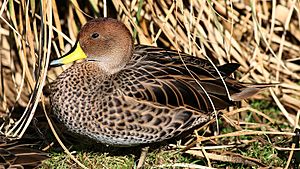Yellow-billed pintail facts for kids
Quick facts for kids Yellow-billed pintail |
|
|---|---|
 |
|
| Conservation status | |
| Scientific classification | |
| Genus: |
Anas
|
| Species: |
georgica
|
| Subspecies | |
|
|
| Synonyms | |
|
|
The yellow-billed pintail (Anas georgica) is a type of South American dabbling duck. Dabbling ducks feed by tipping their bodies forward in the water. This bird is part of the Anas group of ducks. There are three different kinds, or subspecies, of the yellow-billed pintail.
Contents
What Does the Yellow-billed Pintail Look Like?
The yellow-billed pintail has a brown head and a brown neck. Its bill is bright yellow with a black tip. There is also a black stripe that runs down the middle of its bill.
The tail of this duck is brownish and comes to a point. The top part of its wings is grayish-brown. The secondary feathers, which are important for flight, are a dark greenish-black color. The rest of the duck's body is a buffy brown. It has black spots of different sizes all over its body.
Sometimes, people might confuse this duck with the yellow-billed teal. However, you can tell the yellow-billed pintail apart. It has yellow stripes on its bill and is generally larger. Also, yellow-billed pintails usually do not gather in very large groups like some other ducks.
Where Do Yellow-billed Pintails Live?
The yellow-billed pintail lives in many parts of South America. You can also find them on the Falkland Islands and South Georgia. They like open areas.
One type, the South Georgia pintail (A. g. georgica), is the smallest subspecies. It lives only on South Georgia. Scientists believe there are about 1,000 to 1,500 pairs of these ducks.
Another type is the Chilean pintail (A. g. spinicauda). This one is also called the brown pintail. It is found across the South American mainland. Its range stretches from southern Colombia all the way down to the south. It also lives in the Falkland Islands. There are more than 110,000 of these ducks.
Sadly, a third type, Niceforo's pintail (A. g. niceforoi), is believed to be extinct. This duck used to live in central Colombia. It was last seen in 1952. It was only discovered and described in 1946.
These ducks live in many different places. They can be found in lakes and marshes high up in the mountains. They also live in lakes, rivers, and along coasts in lower areas.
Reproduction and Life Cycle
Yellow-billed pintails build their nests on the ground. They make their nests cozy by lining them with grass and soft down feathers. They are very good at hiding their nests. They usually place them in thick plants close to water. This helps keep their eggs safe from predators.
A female yellow-billed pintail will lay a group of eggs called a clutch. Each clutch usually has between 4 and 10 eggs.
Gallery
See also
 In Spanish: Pato maicero para niños
In Spanish: Pato maicero para niños




